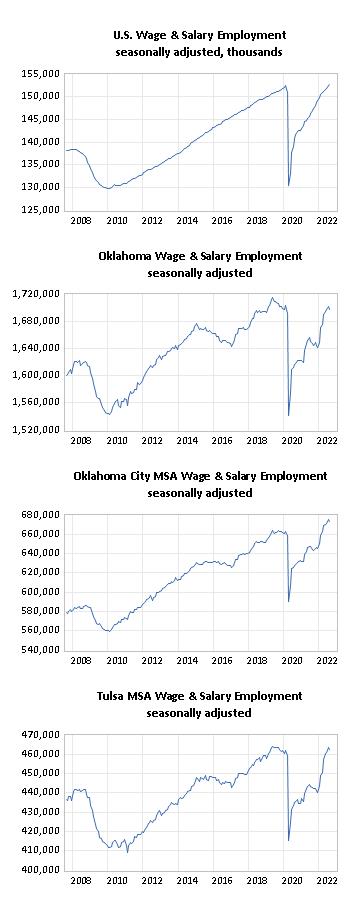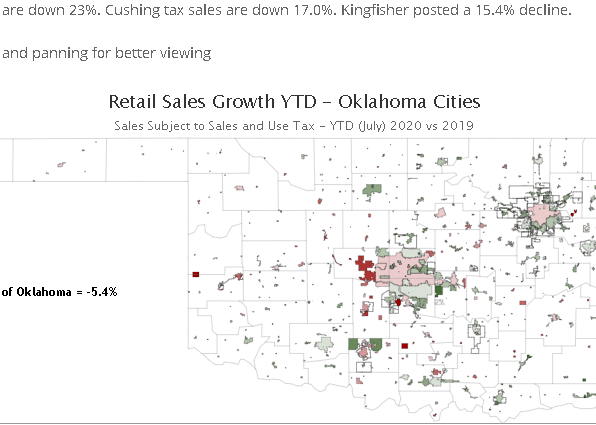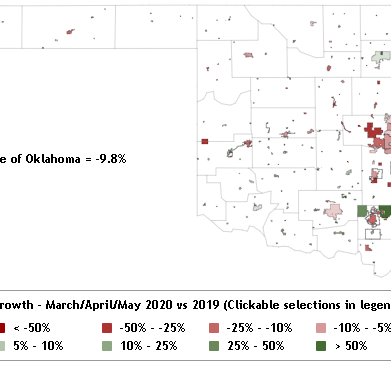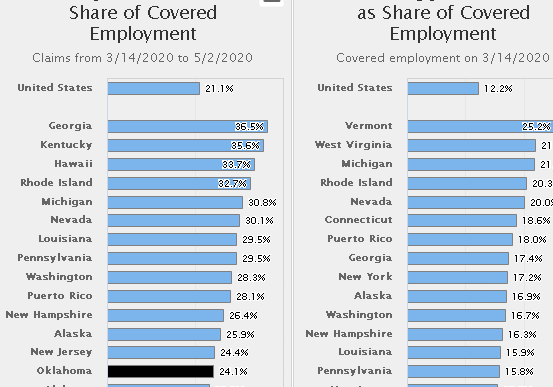Retail sales across Oklahoma's cities continue to improve. State sales subject to both sales and use tax are down only 5.4% year-to-date through July of…
Both OKC and Tulsa Now Firing on All Cylinders

Oklahoma’s post-pandemic recovery has been disappointingly slow relative to the nation.
The state and both major metro areas have lagged well behind the U.S. in job formation during much of the recovery period. An already-stalled economy leading into the pandemic coupled with a demolished state oil and gas industry weighed on the pace of the state’s rebound relative to the nation.
The good news is that 2022 brings the opposite story!
The tide is now turning as the nation slows its torrid pace of post-pandemic hiring and the state of Oklahoma (especially the state’s two major metro areas) accelerates. Hiring ramped up sharply across the state in the first half of 2022 and managed to close much of the gap with the nation. Although the overall state still trails the nation in the pace of job growth, both metros are now adding jobs at a faster pace.
The reversal in job market dynamics, especially in Oklahoma’s metro areas, is striking.
U.S. job growth over the prior 12 months slowed steadily from 4.4% one year ago to 4.0% currently. This reflects the slowing trend in place in most states over the past year.
In contrast, Oklahoma City metro area job growth accelerated from 2.7% a year ago to 4.5% currently. The boost in hiring growth was even more pronounced in Tulsa, which more than doubled from 1.7% a year ago to 4.6% currently. The job gains in both metros are now broad-based and extend across most major industry sectors. Most importantly, the state energy sector has benefitted from elevated energy prices and is now providing a net boost to the state economy.
Rural areas of the state remain a drag on overall state growth.
Despite the strength in OKC and Tulsa, the rural areas continue to struggle to keep pace. Rural weakness has limited overall state job growth to only 2.8% over the past 12 months, up from 1.9% a year ago.
Pandemic-related job losses are now mostly recovered in Oklahoma.
The nation fully recovered all jobs lost in the pandemic in July 2022. On a seasonally adjusted basis, the state is now only slightly below full recovery and should attain it by the end of 2022. OKC is now well above full recovery, and Tulsa reached full recovery in July in lockstep with the nation.
A final positive note is that the acceleration in state and metro area growth is especially timely.
It will undoubtedly mitigate some of the early damage from ongoing Federal Reserve interest rate increases. It should also allow Oklahoma to outperform many other states in the remainder of 2022 and into 2023. Oklahoma has a long history of outperformance in the early stages of a slowdown when energy prices are elevated. The current cycle looks like it may provide another example of this historical pattern.



